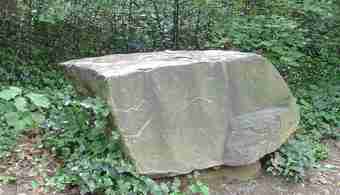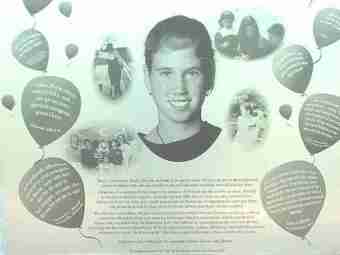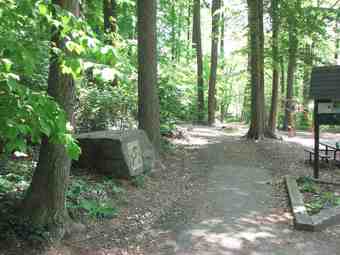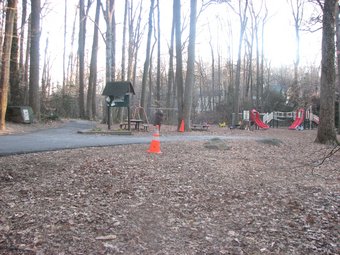Becca Lilly, 1980 - 1997
Becca Lilly Neighborhood Park
7330 Glenside Drive
Becca Lilly Neighborhood Park runs along Long Branch Tributary, close to New Hampshire Ave.
Driving south on Sligo Creek Parkway, a driver would turn left at New Hampshire, left at the first light on Glenside, and park near Merwood Drive, two streets down on the left. A paved path downhill leads to the playground.
The stone before the plaque was added, and the plaque.
Becca (Rebecca) Lilly lived six years after she was diagnosed with brain cancer at age ten. When she lost ground in 1995, gene therapy had become possible and Becca became the first child with a brain tumor to receive the treatment, at Children's Hospital. It did not succeed. Becca completed her junior year at Good Counsel High School (then in Wheaton), but died at home shortly after school ended.
A series of at leats six feature articles by Don Colburn in the Washington Post described Rebecca's last year. One result was that many people hoped and prayed for her, Colburn wrote. "Preschoolers colored for her. A Bethesda man gave her the Bronze Star he had been awarded during World War II. Former first lady Nancy Reagan mailed a jar of jelly beans." Through it all Becca wanted to be an ordinary tenager, and she rarely spoke of her cancer. This Park was dedicated to Becca in tribute to the bravery with which she faced life during her illness.
Text on the Rock
"Becca" loved sports, family, food, life, and God, in no specific order. She grew up here in the Long Branch section of Takoma Park. She loved to play in the park and many a birthday was held near this stone.
A diagnosis of a cancerous brain tumor in the summer of 5th grade did little to slow her down. All through six treatments, surgeries, chemotherapy and MRIs, Becca's focus was always on the Future. Taking care of her baby sister, Sarah, playing with her brother, Joe, or supporting her sister Ann Marie, who played basketball for Marymount University, all took precedence over her condition.
Her other love was children. Because classes at Good Counsel had become a challenge, a special curriculum allowed her to go to St. Andrews Elementary School to work and play with the preschoolers. Becca's story was followed by the Washington Post. (The balloons are quotes from people who wrote the Post, describing how Becca had touched them.) While she enjoyed the fame, it never affected her. She lived with great love, embodying the saying, "Be all you can be." Her tenacity, spirit, and courage remain examples for us all.
Enjoy your time at the park. Try and make it better, cleaner and "funner."
Dedicated September 29, 2007 by the family and friends of Becca Lilly.
See photos of damage to the Park from the 2004 storm.
Becca Lilly Park in summer and winter
|











